|
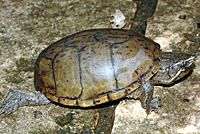 |
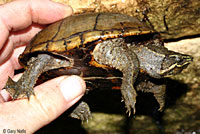 |
 |
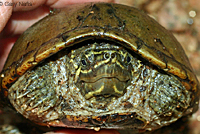 |
 |
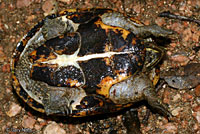 |
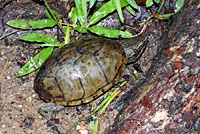 |
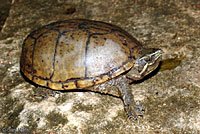 |
|
| |
Adult, Travis County, Texas |
|
 |
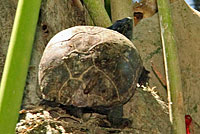 |
|
| |
Adult, Anne Arundel County, Maryland |
|
| |
|
|
| Habitat in Native Range |
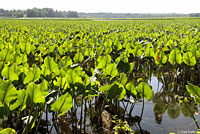 |
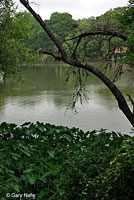 |
 |
| Adult in habitat, Anne Arundel County, Maryland |
Habitat, Travis County, Texas |
Habitat, Travis County, Texas |
| |
|
|
|
Description |
| |
| Size |
Typically 2 - 4.5 inches (5 -11.4 cm) in length with a record of 5 7/8 inches (15 cm).
|
| Appearance |
A small dark turtle with two prominent light stripes on the side of the head and neck, barbels on the chin and throat, and a large stout tail. The carapace is smooth, light olive brown, to nearly black, sometimes with dark spots or streaks. The brownish yellow plastron with dark markings is small with a single hinge. Large areas of skins found between plastral scutes.
Males have a longer and thicker tail than females.
|
| Life History and Behavior |
Crepuscular, sometimes observed basking in sunlight.
Active year round in the warmer part of its native range but hibernates during winter in colder areas, buried in mud or small holes underwater.
A popular pet turtle.
|
| Defense |
When threatened may scratch and bite and release a foul-smelling musk, which explains the alternate common name for the species: "Stinkpot." |
| Diet |
| Invertebrates, algae, and carrion, found in water. Sometimes feeds on land on slugs. |
| Reproduction and Young |
Breeds mainly in spring, occasionally in fall.
Females dig a shallow nest on land where they lay 2-4 eggs that hatch in 2-3 months.
|
| Habitat |
In its native range, found in ponds, lakes, canals, swamps, streams, with little current and muddy bottoms.
According to Hansen & Shedd, 2025 in California "...it occurs in a shallow, urban waterway bordered by extensive non-native vegetation and footpaths" along with native pond turtles and several other species of non-native turtles.
|
| Range |
Distribution in California
According to Hansen & Shedd, 2025, there is a small breeding population of Eastern Musk Turtles that was introduced sometime after 1997 "...at a single site on the University of California campus in Davis (Yolo Co.), where it is associated with a side channel of Putah Creek at the UC Davis Arboretum."
There are also multiple observations on iNaturalist for this species in the Sacramento area, San Francisco, Los Gatos, Los Angeles, Fountain Valley, and coastal San Diego County. They don't appear to represent breeding populations, only lone pet turtles that were released into the wild, but it's possible they have also been established at some of those locations.
Native Range
Occurs throughout most of the eastern U.S. as far north as Canada and as far west as central Texas.
|
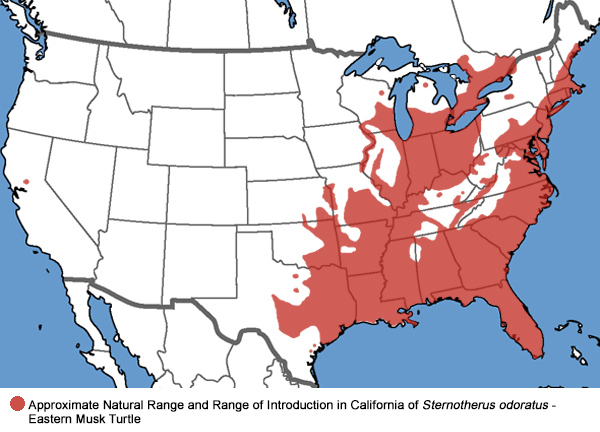 |
Notes on Taxonomy |
Alternate and Previous Names (Synonyms)
Common Musk Turtle
Stinkpot
|
| Conservation Issues (Conservation Status) |
| Maybe eventually become established in other areas where single turtles have been observed if irresponsible pet owners release more turtles. |
|
Taxonomy |
| Family |
Kinosternidae |
American Mud Turtles |
Agassiz, 1857 |
| Genus |
Sternotherus |
Musk Turtles |
Bell in Gray, 1825 |
Species
|
odoratus |
Eastern Musk Turtle |
(Latreille 1802) |
|
Sternotherus odoratus (Latreille, 1801) - Hist. Nat. Rept., Vol. 1, p. 122
from Original Description Citations for the Reptiles and Amphibians of North America © Ellin Beltz
|
Meaning of the Scientific Name
|
Sternotherus: Greek - sterno = chest and thairos = hinged -- refers to the hinged plastron
odoratus: Latin - to have a strong odor -- refers to the odor produced by musk glands
from Scientific and Common Names of the Reptiles and Amphibians of North America - Explained © Ellin Beltz
|
Related or Similar California Herps
|
Actinemys marmorata - Northwestern Pond Turtle
Actinemys pallida - Southwestern Pond Turtle
C. p. bellii - Western Painted Turtle
T. s. elegans - Red-eared Slider
|
More Information and References
|
Robert Powell, Roger Conant, and Joseph T. Collins. Peterson Field Guide to Reptiles and Amphibians of Eastern and Central North America. Fourth Edition. Houghton Mifflin Harcourt, 2016.
Hansen, Robert W. and Shedd, Jackson D. California Amphibians and Reptiles. (Princeton Field Guides.) Princeton University Press, 2025.
Bartlett, R. D. & Patricia P. Bartlett. Guide and Reference to the Turtles and Lizards of Western North America (North of Mexico) and Hawaii. University Press of Florida, 2009.
Carr, Archie. Handbook of Turtles: The Turtles of the United States, Canada, and Baja California. Cornell University Press, 1969.
Ernst, Carl H., Roger W. Barbour, & Jeffrey E. Lovich. Turtles of the United States and Canada. Smithsonian Institution 1994.
(2nd Edition published 2009)
|
|
|
The following conservation status listings for this animal are taken from the July 2025 State of California Special Animals List and the July 2025 Federally Listed Endangered and Threatened Animals of California list (unless indicated otherwise below.) Both lists are produced by multiple agencies every year, and sometimes more than once per year, so the conservation status listing information found below might not be from the most recent lists, but they don't change a great deal from year to year.. To make sure you are seeing the most recent listings, go to this California Department of Fish and Wildlife web page where you can search for and download both lists:
https://www.wildlife.ca.gov/Data/CNDDB/Plants-and-Animals.
A detailed explanation of the meaning of the status listing symbols can be found at the beginning of the two lists. For quick reference, I have included them on my Special Status Information page.
If no status is listed here, the animal is not included on either list. This most likely indicates that there are no serious conservation concerns for the animal. To find out more about an animal's status you can also go to the NatureServe and IUCN websites to check their rankings.
Check the current California Department of Fish and Wildlife sport fishing regulations to find out if this animal can be legally pursued and handled or collected with possession of a current fishing license. You can also look at the summary of the sport fishing regulations as they apply only to reptiles and amphibians that has been made for this website.
This turtle is not included on the Special Animals List, which indicates that there are no significant conservation concerns for it in California.
|
| Organization |
Status Listing |
Notes |
| NatureServe Global Ranking |
|
|
| NatureServe State Ranking |
|
|
| U.S. Endangered Species Act (ESA) |
None |
|
| California Endangered Species Act (CESA) |
None |
|
| California Department of Fish and Wildlife |
None |
|
| Bureau of Land Management |
None |
|
| USDA Forest Service |
None |
|
| IUCN |
|
|
|
|
















